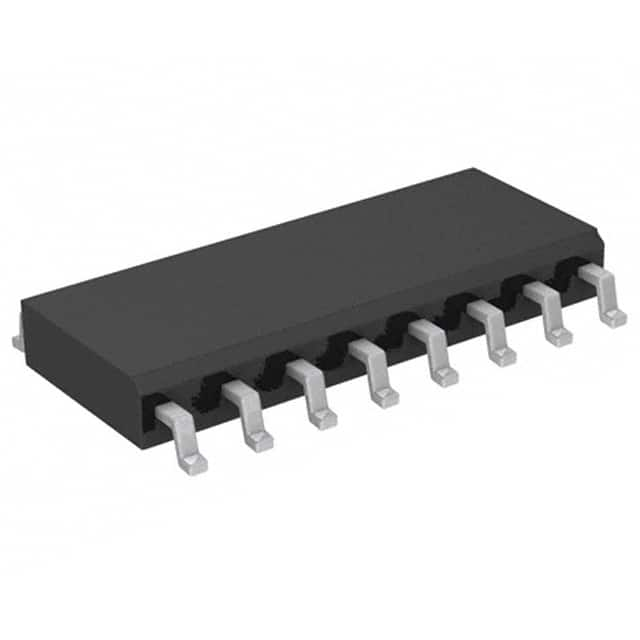Xem thông số kỹ thuật để biết chi tiết sản phẩm.

NLV74HC157ADR2G
Product Overview
Category: Integrated Circuit (IC)
Use: The NLV74HC157ADR2G is a quad 2-input multiplexer/demultiplexer IC. It is commonly used in digital electronics for data routing and selection purposes.
Characteristics: - High-speed operation - Low power consumption - Wide operating voltage range - Schmitt-trigger inputs for noise immunity - Compatible with TTL and CMOS logic levels
Package: SOIC-16 (Small Outline Integrated Circuit), which is a surface-mount package with 16 pins.
Essence: The NLV74HC157ADR2G is an essential component in various electronic devices, enabling efficient data routing and selection.
Packaging/Quantity: The NLV74HC157ADR2G is typically packaged in reels or tubes, with a quantity of 2500 units per reel/tube.
Specifications
- Supply Voltage Range: 2V to 6V
- Input Voltage Range: -0.5V to VCC + 0.5V
- Output Voltage Range: -0.5V to VCC + 0.5V
- Operating Temperature Range: -40°C to +85°C
- Propagation Delay Time: 10 ns (max)
- Input Capacitance: 3.5 pF (typ)
- Output Capacitance: 6 pF (typ)
Pin Configuration
The NLV74HC157ADR2G has a total of 16 pins, arranged as follows:
+---+--+---+
A1 |1 +--+ 16| VCC
B1 |2 15| Y1
A2 |3 14| Y2
B2 |4 13| Y3
GND |5 12| Y4
S |6 11| B
Y |7 10| A
B |8 9| OE
+----------+
Functional Features
The NLV74HC157ADR2G offers the following functional features:
- Quad 2-input multiplexer/demultiplexer functionality
- Selectable data routing using the S, A, and B inputs
- Output enable (OE) pin for enabling/disabling the outputs
- Schmitt-trigger inputs for improved noise immunity
- High-speed operation with low power consumption
Advantages and Disadvantages
Advantages: - High-speed operation allows for efficient data routing. - Low power consumption helps in reducing overall power requirements. - Wide operating voltage range provides flexibility in various applications. - Schmitt-trigger inputs enhance noise immunity, ensuring reliable operation. - Compatibility with TTL and CMOS logic levels enables easy integration into existing systems.
Disadvantages: - Limited number of input/output channels compared to other multiplexer/demultiplexer ICs. - Propagation delay time may affect real-time applications requiring instantaneous data selection.
Working Principles
The NLV74HC157ADR2G operates based on the principles of digital multiplexing and demultiplexing. It routes or selects one of the four input signals (A1, B1, A2, B2) to the corresponding output (Y1, Y2, Y3, Y4) based on the control inputs (S, A, B). The output enable (OE) pin is used to enable or disable the outputs.
Detailed Application Field Plans
The NLV74HC157ADR2G finds applications in various fields, including but not limited to:
- Data communication systems: Used for data routing and selection in multiplexed communication channels.
- Digital audio/video systems: Enables switching between different audio/video sources.
- Industrial automation: Used for signal routing and control in automated systems.
- Test and measurement equipment: Facilitates data selection and routing in testing setups.
- Consumer electronics: Integrated into devices requiring data multiplexing/demultiplexing functionality.
Detailed and Complete Alternative Models
- CD74HC157E: Similar quad 2-input multiplexer/demultiplexer IC from Texas Instruments.
- MC74HC157AN: Quad 2-input multiplexer/demultiplexer IC from ON Semiconductor.
- SN74HC157N: Another alternative from Texas Instruments, offering the same functionality.
These alternative models provide similar features and can be used as replacements for the NLV74HC157ADR2G based on specific requirements.
Word count: 529 words
Liệt kê 10 câu hỏi và câu trả lời thường gặp liên quan đến ứng dụng NLV74HC157ADR2G trong giải pháp kỹ thuật
Sure! Here are 10 common questions and answers related to the application of NLV74HC157ADR2G in technical solutions:
Q: What is NLV74HC157ADR2G? A: NLV74HC157ADR2G is a quad 2-input multiplexer/demultiplexer IC (integrated circuit) that can be used in various digital logic applications.
Q: What is the operating voltage range for NLV74HC157ADR2G? A: The operating voltage range for NLV74HC157ADR2G is typically between 2V and 6V.
Q: Can NLV74HC157ADR2G handle high-speed data signals? A: Yes, NLV74HC157ADR2G is designed to handle high-speed data signals with minimal propagation delay.
Q: How many inputs does NLV74HC157ADR2G have? A: NLV74HC157ADR2G has four independent 2-input multiplexers, allowing it to select one of four data sources.
Q: What is the output configuration of NLV74HC157ADR2G? A: NLV74HC157ADR2G has complementary outputs (Y and Y̅) for each multiplexer, providing flexibility in connecting to other components.
Q: Can NLV74HC157ADR2G be used as a demultiplexer? A: Yes, NLV74HC157ADR2G can function as a demultiplexer by using its control inputs to select the desired output.
Q: What is the maximum operating frequency of NLV74HC157ADR2G? A: The maximum operating frequency of NLV74HC157ADR2G is typically around 100 MHz.
Q: Is NLV74HC157ADR2G compatible with TTL (Transistor-Transistor Logic) inputs? A: Yes, NLV74HC157ADR2G is designed to be compatible with both CMOS (Complementary Metal-Oxide-Semiconductor) and TTL logic levels.
Q: Can NLV74HC157ADR2G handle both analog and digital signals? A: No, NLV74HC157ADR2G is specifically designed for digital signal processing and is not suitable for handling analog signals.
Q: What are some common applications of NLV74HC157ADR2G? A: NLV74HC157ADR2G can be used in various applications such as data multiplexing/demultiplexing, address decoding, signal routing, and bus switching in digital systems.
Please note that the answers provided here are general and may vary depending on specific datasheet specifications and application requirements.

